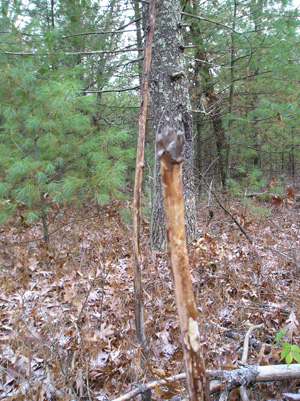Part II of our series of three articles regarding how to read deer sign, focuses on “scrapes & rubs.” Deer “scrape” the ground with their hooves- – and at times will do so with their antlers. The scrapes will range from the size of a dinner plate to that of a child’s portable swimming pool. Put money on the fact that if you find a swimming pool sized scrape , you’ve either got one huge trophy buck, or it’s a “community scrape,” where all the deer are together. That type of community scrape usually means younger, or immature bucks. A mature buck will normally stay to himself and scrape distinct areas to announce his presence and mark his territory.
, you’ve either got one huge trophy buck, or it’s a “community scrape,” where all the deer are together. That type of community scrape usually means younger, or immature bucks. A mature buck will normally stay to himself and scrape distinct areas to announce his presence and mark his territory.
Different types of scrapes mean different types of bucks. Young bucks go along, and they really don’t know what they’re doing. It’s like a 16 year old going out on his first date – -he has some instinctive idea of what he’s supposed to be doing but doesn’t really know the ball game. So young bucks go out and start marking territory everywhere. There’s no rhyme or reason to their scraping. If they see a scrape from another buck, they’ll scrape in the same area, and in the end the area will become a community scrape, of sorts. The young bucks will return to these areas to check out what’s happening. They don’t really recognize that they’re marking the area.
On the other hand, a mature, dominant buck knows exactly what he’s doing. They scrape, and they announce by their scrapes that they’re marking their territory, telling other bucks to stay out of it.
Savvy hunters recognize what are called “scrape lines.” Dominant, big bucks will move up and down and around their territory marking with scrapes anywhere from about every 30 to maybe a 100 yards. They scrape along a specific trail or “line” as it’s called. These scrape lines will attract knowledgeable hunters who will set up along these lines, taking the wind into consideration (remember – -it’s critical to always locate downwind from your quarry), and then the hunters wait for that big trophy to show up on his scrape line.
Very much like the scrape line is a rub line – which is done on trees or bushes. Bucks use these rubs in two instances. The first is when they rub off the velvet on their new set of antlers. Usually that’s earlier in the year and smart hunters know that these rubs may not indicate territorial markings, but rather just the opportunity for the bucks to get the velvet off their antlers. Early in the year, rubs will mostly appear on small saplings or trees, and you can’t tell much about the size of the deer or if there’s any territorial rubbing going on. As the year moves on and the antlers harden, the bucks instinctively try to get the velvet off as quickly as they can. At that time, you can really begin to estimate the size of the deer that’s rubbing. As the rut approaches, you can look at the diameter of the trees that the bucks are rubbing. The bigger or wider the tree, and the larger the antler marks, the bigger the buck. A little forkhorn will not rub against a huge pine tree. Deer will stick to a tree that befits their size. A big 10 or 12 pointer however with a heavy rack will hit on a big tree. That’s what he’s looking for. The real key is if you see a tree which has been rubbed – and it’s big- – and the tree or trees directly behind the primary rubbed tree also have ancillary rubs from the same deer, then you pretty well know that you’re on to something big. The buck was so large that as he wrapped himself around the big, primary tree he was rubbing, he not only hit that tree, but the ones behind it.
What a lot of hunters do is set up trail cameras along scrape and rub lines, which will photograph or take video of the bucks who are rubbing and scraping. The hunter will then be able to closely determine the actual size of the buck who is in the area.
(Resource from:https://www.biggamelogic.com)
